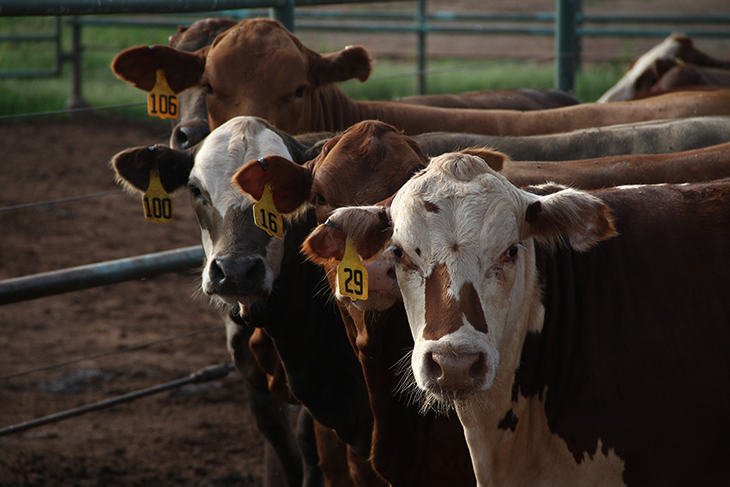U.s. Beef Export to China Projections

Growing demand in China dominates global beef trade
Thursday, September 19, 2019
America's trade war with China has been of concern to many agricultural producers, agribusiness operators and economic analysts, and that includes those with the U.S. beef industry, where increasing U.S. market share in China has been a goal.
"Simply put, China has replaced the United States as the leading beef importer in the world," said Derrell Peel, Oklahoma State University Cooperative Extension livestock marketing specialist. "Chinese beef imports in 2018 exceeded total U.S. beef imports. If the semi-autonomous city of Hong Kong is included along with mainland China, their total imports were larger beginning in 2017."
Total world beef imports have increased by 17.7 percent in the five years from 2015 to projected 2019 totals. During that period, beef imports in China increased 153.4 percent along with a 62.2 percent increase in beef imports into Hong Kong, leading to a 122.6 percent increase in beef imports in the region. In contrast, total beef imports into the United States decreased by an estimated 12.3 percent for the 2015-2019 period.
Peel said increased beef imports into China alone accounted for more than 75 percent of the net increase in total world imports for this period. China accounted for 8.7 percent of world beef imports in 2015. Including Hong Kong brought the 2015 share to 13.1 percent. Total U.S. beef imports in 2015 accounted for 20 percent of global beef imports.
"Projections for 2019 show China importing 18.7 percent of global beef imports along with another 6.1 percent of imports into Hong Kong," Peel said. "This means the region currently accounts for a 24.8 percent share of world beef imports. U.S. beef imports are projected to account for 14.9 percent of world beef imports in 2019."
The rapid growth in Chinese beef imports has dramatically altered global beef flows with several countries now exporting a significant share of total exports to China. A majority of beef imports from Brazil, Uruguay, Argentina, Australia and New Zealand go to China.
"Number one beef exporter Brazil currently ships about 22 percent of total exports to China and accounts for 31 percent of total Chinese beef imports," Peel said. "Brazil sends another 17 percent of beef exports to Hong Kong."
Uruguay is the world's eighth-largest beef exporting country but sends about 70 of its exports to China and accounts for 21 percent of Chinese beef imports. Argentina, the world's sixth-largest beef exporting country sends about 65 percent of total beef exports to the China and Hong Kong. Argentina accounts for 17 percent of Chinese beef imports.
The world's second-largest beef exporter, Australia, ships 16 percent of its total beef exports to China, accounting for 17 percent of Chinese beef imports. New Zealand, the world's fifth-leading beef exporter, sends 26 percent of total exports to China and accounts for 11 percent of total beef imports into the country.
"Notably absent are North American beef exporters," Peel said. "About 2 percent of Canadian beef exports move to China while China accounts for less than 1 percent of U.S. and Mexican beef exports. Hong Kong is an important export market for Canada, 6 percent; the United States, 10 percent; and Mexico, 4 percent.
Numerous factors account for the lack of U.S. market share in China. Despite receiving access to the Chinese market in 2017, U.S. beef exports have shown almost no growth. This has been partly caused by the need to develop markets in China for higher quality, more expensive U.S. beef.
Peel said beef market analysts recognized this was always going to be a lengthy endeavor, even before the process was interrupted by the current trade war between the United States and China, with the additional tariffs on American beef put in place by the Chinese government.
"Chinese restrictions on production technology allowed in beef exported to China – the use of implants, beta agonists and such – mean the supply of U.S. beef available for the Chinese market is limited," Peel said. "The United States is currently caught in a chicken-and-egg situation of not having much supply for the Chinese market and not having enough market potential to warrant increased U.S. production to meet Chinese demand."
Still, Peel contends it is important for the United States to participate in the growing Chinese beef market. At current levels, if the United States could achieve a 10 percent market share of Chinese beef imports, it would add more than 11 percent to total U.S. beef exports, which would be good news for America's beef industry.
The Oklahoma Cooperative Extension Service is one of two state agencies administered by OSU's Division of Agricultural Sciences and Natural Resources, and is a key part of the university's state and federally mandated teaching, research and Extension land-grant mission.
MEDIA CONTACT: Donald Stotts | Agricultural Communications Services | 405-744-4079 |donald.stotts@okstate.edu
SVG directory not found.
Source: https://news.okstate.edu/articles/agriculture/2019/stotts_september-china-trade.html
0 Response to "U.s. Beef Export to China Projections"
Post a Comment